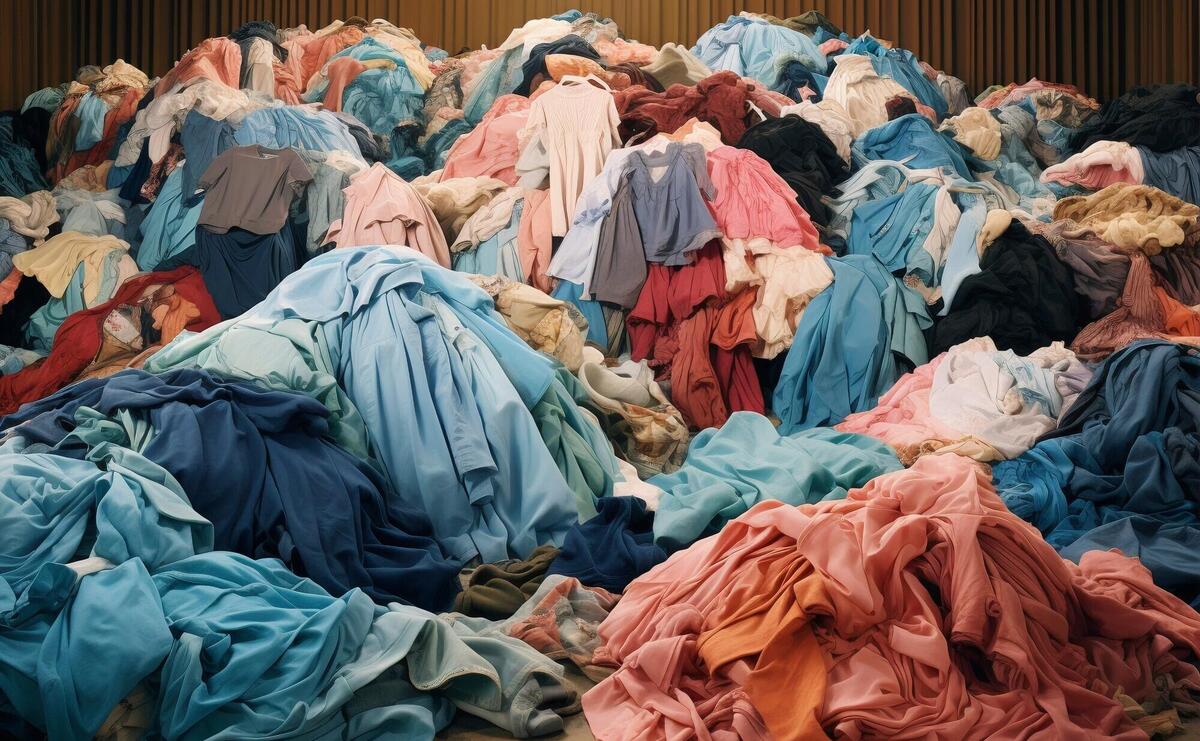Fast Fashion And the Environment: How Your Wardrobe Choices Impact the Earth
Welcome to a world where trends change as quickly as a blink of an eye, clothing is created quicker than ever before, and the environment is someone who always pays the ultimate price.
Fashion with lightning speed has knocked at our closets, having promised to provide us with trendy dresses and nice boots for the most minor price.
However, did we really ever stop to think about just what sorts of choices we are making? Did it actually cross anyone’s mind that ‘in-style’ shirt, purchased for only $10, could’ve had a far greater influence than just a hit on our wallets?
This article is about what our wardrobe choices do to the environment around us. So after you’ve read it, you’ll be asking yourself, “Is this really worth it”?
Summary
- Fast fashion, being responsible for the rapid production and consumption of cheap clothing, puts heavy pressure on the environment.
- Major fast fashion brands, including Zara and Forever 21, are keeping up with the ever-changing trends of fashion by providing buyers with affordable, the trendiest garments at the cost of environmental degradation, together with labor exploitation practices.
- The consequences of fast fashion to the environment include deforestation, damage to land, excessive usage of water, pollution from synthetic materials, and massive textile waste to soil.
- To avoid fast fashion, choose sustainable brands, buy second-hand or vintage, and prioritize quality over quantity.
- By making conscious wardrobe choices and promoting sustainability, we can reduce the environmental harm caused by fast fashion on the planet.
Fast Fashion Definition

Fast fashion is the rapid mass production of inexpensive clothing and accessories responding quickly to consumer demands and current fashion trends. If in the late 1990s, people bought new clothes several times per year, now they can do it every day!
The fast fashion market has become more popular in recent years, as retailers are able to react more quickly to the new trends on the catwalk than ever before. The main retailers who depict fast fashion in everyday life are Zara, Forever 21, and H&M.
The easiest way to captivate fast fashion is to picture the second a trend is presented at New York Fashion Week, and within a few weeks, that knockoff trend is manufactured at a 10th of the price with the exact same appeal. In this way, it is simply a little late to the party.
Fast fashion companies cheaply knock off the real trend presented by fashion houses and then can sell it for a lot less due to the cheaper materials used. After that, you can find this piece at a viable cost in the stores only a month after it was first presented on the runway.
Fast Fashion Vs. Slow Fashion

Fast and slow fashion represent two vastly different approaches to producing and selling clothing.
Fast fashion clothing brands like Zara and Forever 21 market their ability to race from design to shelf with trendy clothes inspired by luxury brands but priced much cheaper.
These companies mass produce cheap, low-quality garments that don’t last very long before becoming “unfashionable” or simply falling apart.
Slow fashion brands, however, operate on the idea of slow growth and intentional choices.
Everlane and Patagonia, for example, source low-cost goods, pay workers in developing countries living wages, design durable goods, reduce waste through recycling programs, and encourage their customers to buy less but choose well.
For example, a fast fashion company may sell a synthetic T-shirt that was made cheaply from poor-quality fabrics in a garment factory with subpar health and safety conditions.
A slow fashion brand, on the other hand, may make a T-shirt out of good quality organic cotton that was produced sustainably with a minimal design and influence to keep the piece looking good for longer than fast fashion pieces do.
Fast Fashion Business Model

At its core, the fast fashion clothing industry is all about speed, efficiency, and mass production. Trend forecasting is the first step in the fashion process.
Fashion designers and marketers predict which styles will be popular in the upcoming seasons. This information is necessary to create designs that are similar or imitations of the latest fashion collections presented at Fashion Week.
Once the designs have been finalized, the manufacturing process begins. Clothing is often mass-produced in other countries where labor costs are low and regulation is not enforced.
Workers in these countries are often paid very small amounts of money and are subjected to hazardous working conditions and poor labor practices. In some instances, clothing is made in American sweatshops or factories that do not obey labor laws, such as the minimum wage.
Many fast fashion brands and companies run large quantities of products at a time, with an amazing turnaround of less than four months from the original thought to the actual product. Businesses lose money if the clothing is not gone within that time period.
The fast fashion empire satisfies the customer’s need to stay trending and keep up with the constantly changing fashion world. Retail giants, such as Zara and H&M, are constantly getting trucks full of brand-new clothes four seasons a year.
Not only do companies like these bring in new merchandise once a week, but some even bring in new merchandise two to three times a week to keep you guessing.
Fast fashion works solely on the very principle of making you feel like you have to continually spend money on materialistic items!
Fast Fashion Industry Leaders
The fast fashion industry is dominated by a few companies that have made their way to capitalize on the consumer demand for affordable, trendy clothing. Here are some of the biggest players in the fast fashion sector:
Zara
Zara, owned by Inditex, seemed to come out of nowhere but is now so popular that it often finds itself in the number one spot when it comes to analyzing which is the biggest fast fashion brand.
From textiles to shoes to accessories, it’s all about fast fashion at Zara, a company that takes just weeks to develop a new product and get it to market.
H&M
Known for its collaborations with high-end designers, such as Versace, Alexander Wang, and Balmain, H&M makes it easy for shoppers to land the latest trends without breaking the bank.
Sometimes, the lines outside H&M stores on the day of a release are longer than the polls for the recent presidential election – and that is not an exaggeration.
Forever 21
Targeting the junior market, Forever 21 is a pioneer in fast fashion. Creating a replica of something seen on a celebrity or on a social media influencer in a matter of days is fast fashion 101.
It’s the reason that Forever 21 has come as close as it has to conquering the world, so it’s perhaps a little surprising to some to hear that in 2019, with sales down and competition up, the company filed for bankruptcy.
Primark
Primark is the epitome of fast fashion. Walking into a Primark store is like entering the Disneyland of the retail world. They have everything, and it’s all so... cheap.
The prices are so low, in fact, that a lot of consumers find them to be too good to be true. Yet that doesn’t stop Primark from delivering them like mushrooms. Grab it while you can is the company’s motto, with a resulting rapid turnover of stock.
ASOS
When it launched more than a decade ago, ASOS (As Seen On Screen) was a place to buy clothing and accessories inspired mostly by celebrities. Now, it’s so much more than that, rivaling some of the other fast fashion retail conglomerates in terms of styles and fashion trends.
Pros And Cons of Fast Fashion Brands

The popularity of fast fashion brands can be directly attributed to the affordability and the ever-changing trends they offer. However, one would not dispute that there are both pros and cons to this trend.
Pros of Fast Fashion Companies
- Affordability: It is no secret that high-street brands offer clothing at a fraction of the price that high-end or designer brands do. Being able to mass manufacture the same or similar items at such a rapid pace dictates a reasonable end retail price.
- Trendy Designs: Being at the forefront of the fashion industry and keeping up with the current trends has always been what fast fashion does best. Girls all over can wear the same latest trends as those who model them on the runway for $10.
- Variety: No doubt fast fashion has the upper hand on this one. New drops every week in-store and new collections released on a monthly basis online give consumers a wide range of styles to choose from.
- Availability and Convenience: We don’t think we can walk more than a block without a Forever 21 in sight. In fact, Forever 21 has been known to open up multiple locations within a two-mile radius. And, of course, you can’t forget their 24-hour online store, which offers clothing, accessories, and shoes for the entire family.
Cons of Fast Fashion Retailers
- Quality: Unfortunately, the saying does ring true - “you get what you pay for.” The lower the cost of clothing, the less the quality. A dress from Primark or Fashion Nova, which costs $4.99 for the most part, will not last for more than one season and will be thrown away. And a dress from Nordstrom at $99 may last forever. Just saying...
- Environmental Impact: The mass production of fashion creates products using highly hazardous chemicals and substantial amounts of water and energy. It is quite time-consuming to produce the amount of cotton needed for only one pair of jeans, let alone denim jackets and jumpsuits coveted by the hundreds.
- Ethical Concerns: Whilst our demand for clothing only spurs more companies to make more (and cheaper) items, fast fashion companies must keep up in an industry that quickly moves along. Therefore, they choose to outsource their manufacturing overseas to countries with low-wage labor (not with fair labor practices) and a lack of regulation and enforcement.
- Disposable Culture: People tend to go through clothes quickly and throw them out frequently without giving them a second thought. Fast fashion has largely helped cause this notion of our society. People are buying clothing items not so much out of necessity but because they see something cheap and think they have to have it.
Environmental Impact of Fast Fashion
The environmental impact of fast fashion should not be underestimated. The production and consumption of disposable clothing have negative effects on the planet. Whether in terms of greenhouse gases, water, the use of raw materials, or pollution, it is very costly. Let's analyze why:
Water Usage

Producing cheap clothes has a devastating effect on the environment, causing huge water pollution. The apparel production system to create cheaply made clothing is a major water consumer and polluter.
The fashion industry produces 79 trillion liters of wastewater and consumes 1.5 trillion liters of water annually, creating 20% of global industrial wastewater. Such high water consumption also results in serious local water losses in countries like China and India, which are already facing water shortages.
In addition, the fashion industry’s plastic waste and textile waste storm into rivers and oceans. The fast fashion industry actually contributes to about 8-10% of global carbon emissions and is the second largest consumer of the world’s water supply.
Microfibers

Microfibers are tiny fibers that come out of our clothing in the wash and travel the world's sewer systems to the seas.
Up to 700,000 microfibers can be released into the environment per single clothes-washing cycle, meaning it is impossible to live somewhere that is unaffected by this level of pollution.
Through textile laundering wastewater, microfibers end up in aquatic environments, making up 85% of human-made debris on shorelines around the world.
Since they are chemically and physically fragmented throughout the lifecycle of clothing, yet not biodegradable, microfiber pollution can only worsen as these plastics age in the environment.
Fast fashion is one reason why there's so much of it - with little regulation, retailers are increasingly using low-quality, inexpensive microfibers to meet the insatiable demand for the latest style.
Greenhouse Gasses

The fast fashion industry is a huge contributor to greenhouse gas emissions; the overproduction and overconsumption of cheap clothing create a carbon footprint greater than the combined footprints of the shipping and aviation industries.
The sector creates about 8-10% of global emissions, more than all international flights and maritime shipping.
From the production of textiles to the manufacturing of garments, each step of making a product requires great amounts of energy and water to emit as much greenhouse gases.
It’s estimated that the fashion industry uses about 1.715 billion tons of CO2 annually, which is bigger than the carbon footprint of Germany, Japan, and France — combined.
Deforestation And Land Damage

Fast fashion has serious environmental consequences, such as deforestation and land degradation.
Some of the raw materials sourced for use in the textile industry include viscose, cotton, and leather. These take the expense of the forests and different ecosystems that do exist in the world.
The vast majority of crops that people grow in their modern agricultural system are composed of a mix of synthetic inputs, including pesticides, herbicides, and chemical fertilizers.
The impacts of these chemicals from agriculture can be perceived in negative implications on the quality of the soil and water supplies through chemical run-off as well as the surrounding flora and fauna.
Besides, some kinds of textiles used in the apparel industry production are made simply from fossil fuels or petroleum. The extraction of petroleum is conducted through drilling into the Earth’s crust, and as a result, it destroys natural habitats, wiping out delicate environments.
Toxins

Toxic substances constitute another key concern about the ecological costs of fast fashion. At virtually every stage of its lifecycle, the textile industry uses and releases hazardous substances that harm both the environment and human health.
The garment industry relies heavily on chemicals such as bleach, dye, and finishing agents, which are used in all sorts of processes like dyeing, printing, and bleaching. These work stages commonly use chemicals such as lead, mercury, and cadmium, as well as phthalates and formaldehyde.
These substances can enter the groundwater and accrue in soil when untreated wastewater is discharged from textile factories and when garments end up in landfills.
And it is garment workers who are most at risk from these toxins. Textile workers are directly exposed to toxic chemicals, whether by breathing them in or skin contact.
The consequences for laborers can include a litany of health problems, including respiratory problems, skin conditions, hormonal problems, and cancers.
Not only do these pollutants stick around for a long time, but they can also collect in ecosystems and make their way back to us through the food supply chain.
Textile Waste

Fast fashion is a main contributor to textile waste. The industry’s production and quick turnover of garments result in an excessive amount of waste. Approximately 85% of textiles are sent to landfills, taking up space and creating growing greenhouse gas emissions.
The tragic event at Rana Plaza in Bangladesh in 2013 brought international attention to the human and environmental costs of fast fashion.
The collapse of the building that held multiple garment factories killed over 1,100 people, exposing the horrific labor standards and working conditions for the majority of workers in these factories.
It’s our disposable culture that is fed by fast fashion that encourages people to dispose of garments after wearing them a few times, which again speeds up the process of textile waste.
Many garments are also primarily made up of a synthetic material called polyester, which takes ages to decompose.
How to Avoid Fast Fashion?
Choosing to steer clear of fast fashion is a conscious step toward practicing mindful consumption and supporting better environmental and labor practices.
While there is no foolproof way of avoiding unethical practices in fast fashion, here are some steps you can take:
- Buy Less, Choose Well: Quality over quantity is the modern mantra. Instead of buying little and often, invest in timeless, high-quality garments that you can see yourself wearing for years.
- Support Sustainable and Ethical Brands: Thanks to the rise in consumer consciousness around fast fashion, there has been a big push recently for brands to clean up their act. Do your research. Ask brands about their supply chain and sustainable fashion. Many now have statements on their websites saying how their clothes are made and the standards their workers are paid and treated.
- Shop Vintage and Secondhand: People have been wearing clothes forever, so why do we always feel that we need to buy new? Shopping secondhand is not only a way of avoiding buying into the environmental and social ills of the clothing industry but also a chance to build your own unique personal style. It’s a win-win.
- Practice Slow Fashion Principles: Instead of buying clothes for one-time wear only to have them disintegrate after a few cycles in the washing machine, how about borrowing or renting?
- Take Good Care of Your Clothes: Extend the lifespan of your clothes by taking proper care of them. Hand-wash when you need to, mend small holes, and follow the laundry instructions. Your clothes will last longer, which means you’ll have to replace them less often.
Conclusion
It is very easy to forget in this fast-fashion world how big an impact our wardrobe choices have on our planet. Fast fashion, responsible for deforestation, damage of lands, waste of textiles, and others, is the ultimate example of the disastrous results of the unrestricted consumer and producing mania.
But supporting sustainable and fair trade, embracing slow fashion, and making thoughtful choices with our wallets will emancipate us from the cycle of fast fashion.
Each piece that we choose may either harm or protect the Earth. Let us be part of cleaning up the fashion industry and preserving this Earth for a greener future, one stitch at a time.
Frequently Asked Questions
What Is a Simple Definition of Fast Fashion?
Fast fashion means the fast production and common consumption of clothes, where fashions change so often that the resulting garments are likely to be very cheap and quickly adaptable but also tend to become worthless due to unrelenting shoddiness.
Is H&M Fast Fashion?
Yes, H&M is a cheap, trendy, fast fashion brand. They operate on principles such as affordable pricing that mimics the latest trends and fast-moving clothing items.
Why Fast Fashion Is So Cheap?
Mostly, fast fashion brands use cheap quality materials and mass production processes in trying to retain low costs of production. In most occurrences, they outsource the production of items to countries with cheap labor, driving the cost down and ultimately making products affordable for the consumer.
What Is the Biggest Problem With Fast Fashion?
The biggest issue of fast fashion is its negative environmental impact. From immense water use, deforestation, and the contribution of textiles to landfills, fast fashion causes massive pollution, aids resource depletion, and destroys ecosystems. Further, it is typically linked to poor working conditions in the supply chain that violate basic human rights.